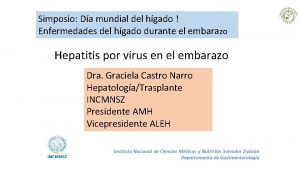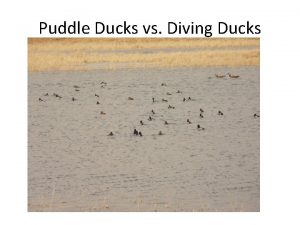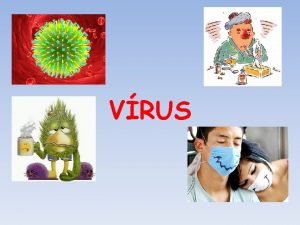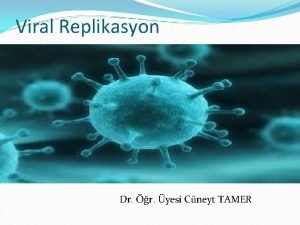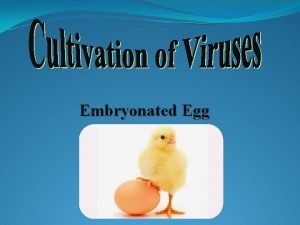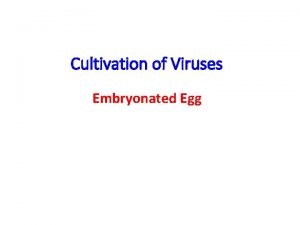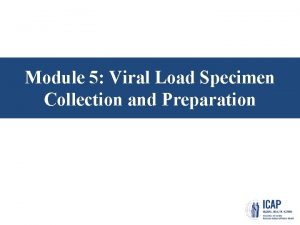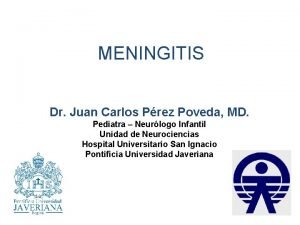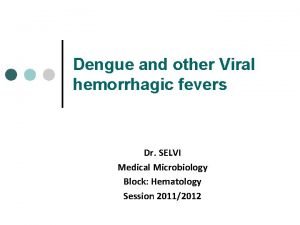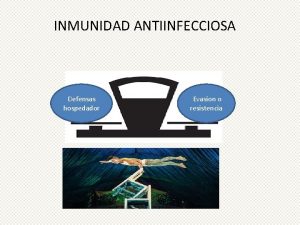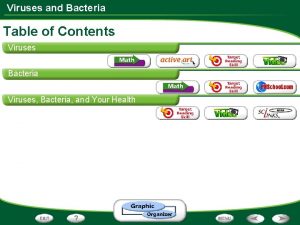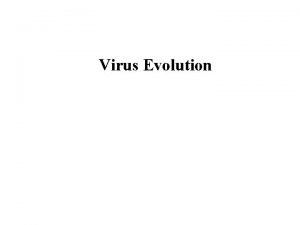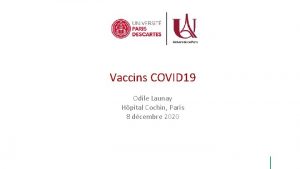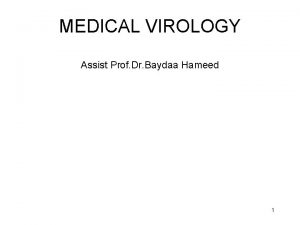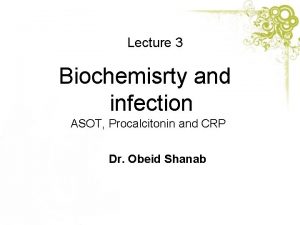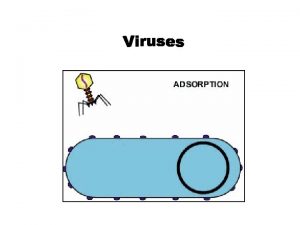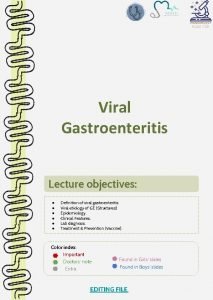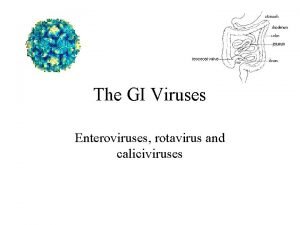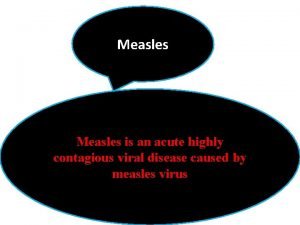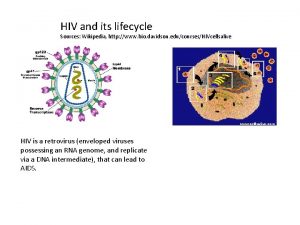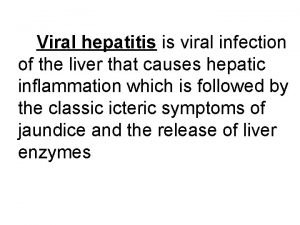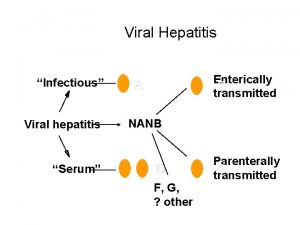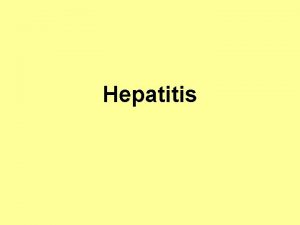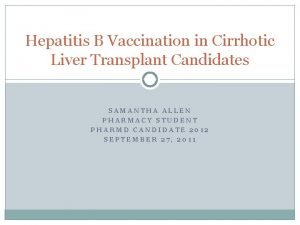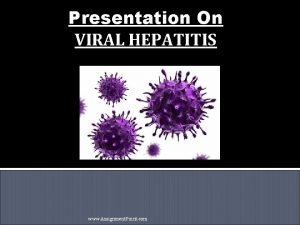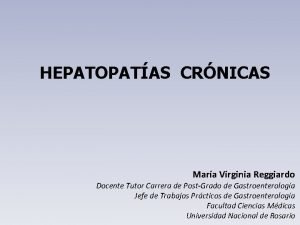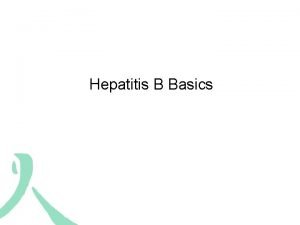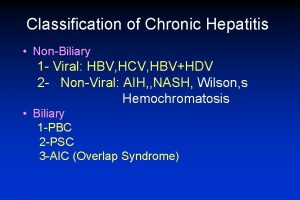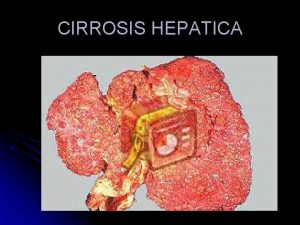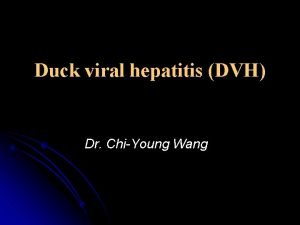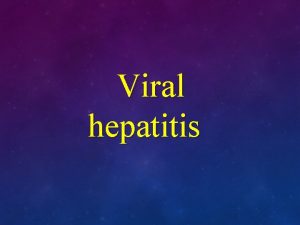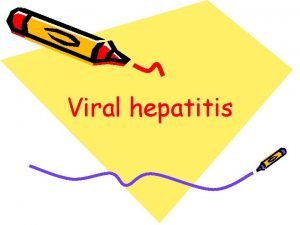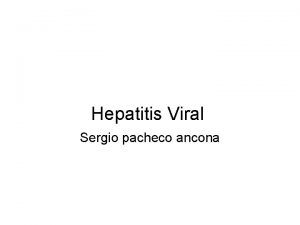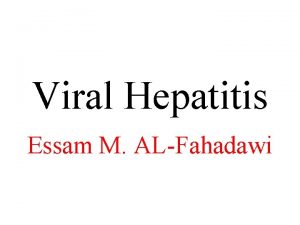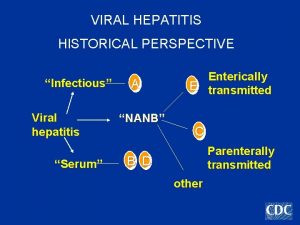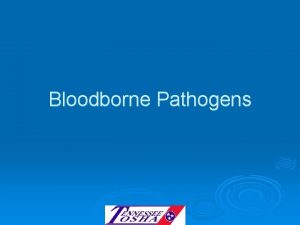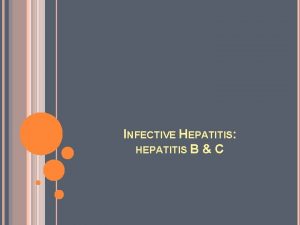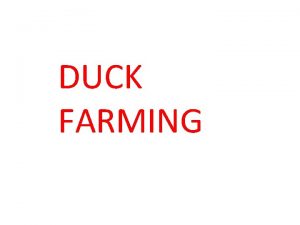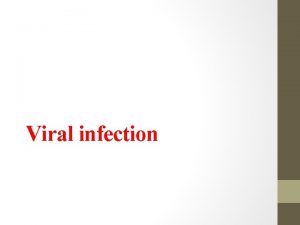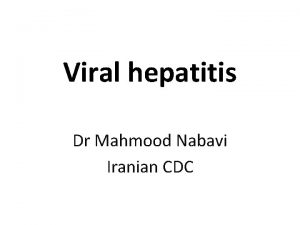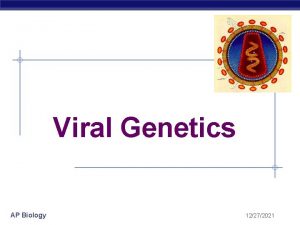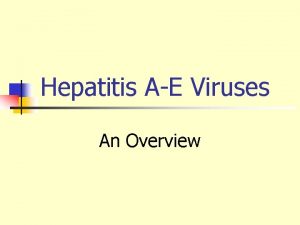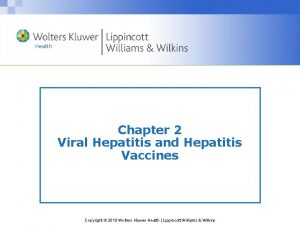Duck viral hepatitis DVH Definition Duck viral hepatitis




















































- Slides: 52

Duck viral hepatitis (DVH)

Definition: �Duck viral hepatitis is an acute and peracute, highly contagious, viral disease of young ducklings characterized by a short incubation period, sudden onset, high mortality, and characteristic liver lesions

Etiology: � Duck viral hepatitis is caused by at least three different RNA viruses, namely duck hepatitis virus (DHV) types I, II and III. � DHV type I, is an enterovirus (The most common type). � DHV type II is considered to be an astrovirus. � DHV type III is considered to be a picornavirus. three viruses named as duck hepatitis viruses

� DHV type I, an enterovirus of family picornaviridae: propagated in chick and duck embryos via Allantoic route of inoculation at 9 -11 days old chicken embryo or 10 -14 day in embryonated duck eggs causing death of embryos at 5 -6 days post inoculation and dead embryos may show cutaneous hemorrhages and edema as well as enlarged greenish liver. Propagated on cell culture (duck embryo liver (DEL) cell cultures) causing cytopathic effect (CPE), which is characterized by cell rounding and necrosis of cells.

Have no Haemagglutination character. resistance to ether and chloroform and it's relatively heat stable.

Susceptibility: � It is a disease of ducks (particularly duckling is the natural host ), usually affects ducklings under 6 weeks of age and often much younger may reach one week. � Experimentally affect other birds as goslings pheasant and bay guinea fowl. � Three distinct types of duck hepatitis virus (DHV) have been isolated from diseased ducklings and adult ducks are apparently unaffected (Age resistance) (no drop in production or fertility) �

Transmission � The disease can be transmitted by direct or indirect contact between the infected ducklings to healthy susceptible one. � NO vertical transmission. � Wild birds act as a mechanical carrier for the virus over a short distance. � Rats virus have been reported as a reservoir host of the

Incubation period � The incubation period for Type I virus is 18 -48 hr.

Clinical signs: � Affected ducklings become lethargic, lose balance, paddle spasmodically, and die within minutes, typically with opisthotonos. � Mortality may be as high as 95% in ducklings. Practically all deaths occur within 1 week after onset of signs. � In adult ducks the infection is un apparent (NOT show any signs) especially in ducks >7 week old. � Both DHV Type II and III infections occur in ducklings despite immunity to Type I virus.





Post Mortem Lesions: � The liver is enlarged and covered with ecchymotic or punctuate hemorrhages. � The spleen may be enlarged and mottled. � Kidneys may be swollen, and renal blood vessels congested. � Morbidity is 100 % and mortality in 1 week old may reach 95 % and in 1 -3 weeks old may reach 50 %.




Diagnosis: Clinical Diagnosis: A. Case history: (rapid onset, short course) B. clinical signs: (paddling of the legs, Opisthotonos) C. PM lesions: (characteristic liver lesions). II. Laboratory Diagnosis: 1 - isolation and identification of the virus: A- isolation of the virus: q Sampling: blood and infected organs (liver). I.

- Isolation and propagation of the virus: On embryonated chicken or duck eggs via allantoic sac. On cell culture. Duckling pathogenicity test: By S/C or I/M inoculation of the isolate into ducklings q - between 1 and 7 days of age…. . Producing the characteristic clinical signs of the disease, with deaths occurring within 1848 hours of inoculation, often in less than 24 hours Identification of the virus by serological tests as VN test. III. Differential diagnosis: DVE, paratyphoid in ducks. q

Prevention of DVH: � Sanitation and sound management: § § � restricted Biosecurity measures. Strict isolation, particularly during the first 5 wk of age. Contact with wild waterfowl should be avoided. Rats control. Vaccination: 3 types of vaccines: 1) modified live virus vaccines. 2) inactivated DHV Type I vaccine. 3) chick-embryo origin, modified live Type I virus. Used in ducklings. Used in breeder flocks

1. Modified live virus vaccines: q used for immunization of breeder ducks. q Given by S/C in the neck. q Given at 16, 20, and 24 week of age and every 12 week throughout the laying period 2. Inactivated DHV Type I vaccine: q used as a booster dose to primary modified live virus vaccine and given to breeder ducks. q Given by I/M before the birds come into lay. q Given in a single dose. 3. The chick-embryo origin modified live Type I virus vaccine q used for early vaccination of ducklings susceptible to Type I (progeny of non immune breeders). q administered SC or by foot web stab in a single dose to dayold ducklings. q Vaccinated ducklings rapidly develop an active immunity over 3 -4 days. q q

Control DVH � By production of antibody against Type I virus, which prepared from the eggs of hyperimmunized chickens, administered SC in the neck at the time of initial loss, is an effective flock treatment.

Duck viral enteritis (DVE) (Duck plaque)

Definition: � DVE is an acute, highly contagious disease of ducks, geese, and swans of all ages, characterized by sudden death, high mortality (particularly among older ducks), and hemorrhages and necrosis in internal organs.

Etiology: � Herpesvirus. � causes intranuclear inclusion bodies in infected tissues and in inoculated cell cultures. � The virus is relatively sensitive to heat and p. H; lipid solvents, trypsin. � Propagated on CAM of 9 - to 14 -day-old embryonated Muscovy duck eggs may result in isolation of the virus. � I/M inoculation of day-old ducklings and observe the pathogenicity of the disease. (more sensitive than egg inoculation). � � Propagated on cell cultures producing cytophatic effect

Susceptibility: � Ducks, geese, and swans of all ages � Particularly � Muscovy among older ducks. ducklings are more susceptible than White Pekin ducklings.

Transmission � The disease can be transmitted by direct or indirect contact between the infected duck to healthy susceptible one. � Ingestion of contaminated water with the virus. � Recovered birds may remain carriers and act as source of infection for susceptible ducks.

Clinical signs: q The incubation period is 3 -7 days. q Sudden high and persistent mortality, Adult ducks may die in good flesh q Dead males may have prolapse of the penis q Photophobia, Inappetence. q extreme thirst, droopiness, ataxia, nasal discharge. q soiled vents, and watery or bloody diarrhea. q In laying flocks, egg production may drop sharply q Ducklings show dehydration and weight loss, blue beaks and bloodstained vents




Blood-stained ice from the nasal discharge of a wild duck dying from duck plague


Post Mortem Lesions: � Petechial and ecchymotic hemorrhages on the heart (paint brush appearance), liver, pancreas, mesentery, and other organs are characteristic � Hemorrhages in various tissues and free blood in body cavities indicate severe damage to blood vessels throughout the body � Specific mucosal eruptions, found in the oral cavity, esophagus, ceca, rectum, and cloaca.

Multiple pale foci in liver and slightly smaller dark-colored spleen

reddened ring visible on the external surface of the intestine








Extensive ulceration of esophageal mucosa.



Bursal lesions; hemorrhages (center) and cheesy exudate (right and left)

Diagnosis: Clinical Diagnosis: A. Case history B. clinical signs. C. PM lesions. II. Laboratory Diagnosis: 1 - isolation and identification of the virus: A- isolation of the virus: � Sampling: from liver, spleen, or kidney tissues I.

q Isolation and propagation of the virus: - On embryonated duck eggs via CAM. - On cell culture. � Identification of the virus by serological tests as VN test and Fluorescent antibody test III. Differential diagnosis: DVH, pasteurellosis, necrotic and hemorrhagic disease, avian influenza enteritis, Newcastle

Prevention of DVE: I) Sanitation and sound management. II) Vaccination: 1. A chicken-embryo-adapted, modified live virus vaccine : 0. 5 m. L is administered S/C or I/M to domestic ducklings >2 wk of age with a booster inoculation a year later.

Control of DVE q There is no treatment for the disease q Control is affected by depopulation, removal of birds from the infected environment, sanitation, and disinfection.

Thanks
 Ventanas dvh
Ventanas dvh Hepatitis viral
Hepatitis viral Puddle ducks characteristic
Puddle ducks characteristic Aerochamber definition
Aerochamber definition Replicação viral ciclo lítico e lisogênico
Replicação viral ciclo lítico e lisogênico Section 24-1 viral structure and replication
Section 24-1 viral structure and replication Inklüzyon cisimcikleri
Inklüzyon cisimcikleri Viral inoculation in embryonated egg
Viral inoculation in embryonated egg Viral inoculation in embryonated egg
Viral inoculation in embryonated egg Egg inoculation technique
Egg inoculation technique Spasmodic croup vs viral croup
Spasmodic croup vs viral croup Varicela variola
Varicela variola Exocitose
Exocitose When blood sample hemolyzed
When blood sample hemolyzed Meningitis viral antibiótico
Meningitis viral antibiótico Causes of viral hemorrhagic fever
Causes of viral hemorrhagic fever Ciclo viral
Ciclo viral Viral infection
Viral infection Viral
Viral Viral recombination
Viral recombination Vaccins à vecteur viral
Vaccins à vecteur viral Viral receptors
Viral receptors Streptococcus
Streptococcus Rhinopneumonitis definition
Rhinopneumonitis definition Virus dna
Virus dna Dha mcq
Dha mcq Viral entry
Viral entry The dynamics of viral marketing
The dynamics of viral marketing Menigitis csf
Menigitis csf Viral arthritis
Viral arthritis An acute highly contagious viral disease
An acute highly contagious viral disease Viral life cycle
Viral life cycle Infinitive viral infection
Infinitive viral infection Viral shedding
Viral shedding Eline's viral
Eline's viral Andrew lippman mit
Andrew lippman mit Hiv life cycle wikipedia
Hiv life cycle wikipedia Vacina trplice viral
Vacina trplice viral Hepatitis types table
Hepatitis types table Hepatitis e
Hepatitis e Window period of hepatitis b
Window period of hepatitis b Symptoms of gonorrhea
Symptoms of gonorrhea Std refers to *
Std refers to * Esquema de vacaciones en mexico
Esquema de vacaciones en mexico Hepatitis f y g
Hepatitis f y g Hepatitis c symptoms in men
Hepatitis c symptoms in men Hepatitis b vaccine series adults
Hepatitis b vaccine series adults Hepatitis d
Hepatitis d Bare area of liver
Bare area of liver Hipovolemia
Hipovolemia Hepatitis b
Hepatitis b Classification of chronic hepatitis
Classification of chronic hepatitis Dosis de lactulosa en encefalopatia hepatica
Dosis de lactulosa en encefalopatia hepatica

